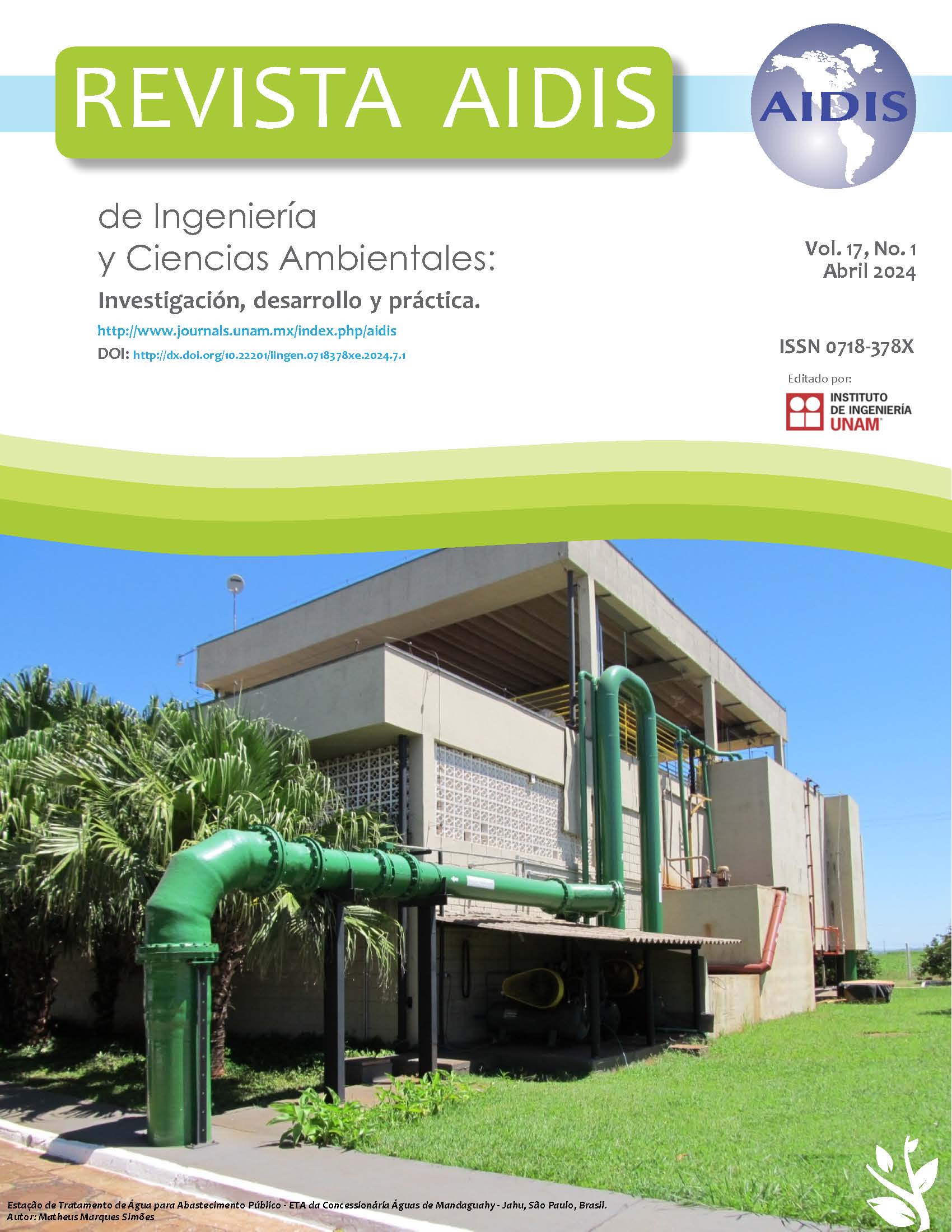Use of hydraulic simulation as a tool in decision making in water supply network: a case study in the Brazilian city of São Gabriel, RS
Contenido principal del artículo
Resumen
Population care by water supply networks has evolved in the world but it is still not a reality for the entire population. In the existing systems, almost 40% of the volume of water available does not reach the user. An important variable that influences water losses in the system is the pressure. In this work, part of the water distribution system in the Brazilian city of So Gabriel, in the state of Rio Grande do Sul (RS), was evaluated through hydraulic simulation using [public domain, water distribution system modeling software package developed by the United States Environmental Protection Agencys (EPA) Water Supply and Water Resources Division] EPANET in three different scenarios: maximum, minimum and sustainable water consumption. In the simulations, the pressures and speeds in the distribution system were analyzed, which allowed the proposition of interventions such as: installation of accessories (pump and pressure reducing valves), reducing diameters of some pipe sections, alteration of the operating regime of already existing pumps, system sectorization and estimates of loss reduction resulting from these interventions.
Detalles del artículo
Citas en Dimensions Service
Citas
ABNT (Ed.) (2017) NBR12.218 Projeto de rede de distribuição de água para abastecimento público.
Adachi S, Takahashi S, Kurisu H and Tadokoro H (2014) Estimating area leakage in water networks based on hydraulic model and asset information. Procedia Engineering 89, 278–285.
Araujo LS, Ramos H and Coelho ST (2006) Pressure control for leakage minimisation in water distribution systems management. Water Resources Management 20, 133-149.
Baggio M, ao AG, Rosito CA, Tardelli J and Ajzenberg M (2013) Perdas em Sistemas de Abastecimento de Água: Diagnóstico, Potencial de Ganhos com sua Redução e Propostas de Medidas para o Combate. Technical report, Associação Brasileira de Engenharia Sanitária e Ambiental.
Barroso LB and Gastaldini MCC (2010) Redução de Vazamentos em um Setor de Distribuição de Água de Santa Maria-RS. Revista Brasileira de Recursos Hídricos 15(2), 27–36.
Bolognesi A, Bragalli C, Lenzi C and Artina S (2014) Energy efficiency optimization in water distribution systems. Procedia Engineering 70, 181–190.
Castro MAH and Costa LHM (2004) Otimização de redes de distribuição de água usando a metodologia de Morgan e o EPANET. In IV Seminário Hispano-Brasileiro sobre Sistemas de Abastecimento Urbano de Água.
Farina G, Creaco E and Franchini M (2014) Using epanet for modelling water distribution systems with users along the pipes. Civil Engineering and Environmental Systems 31(1), 36–50.
Ganorkar RA, Rode PI, Deshmukh SA and Dhoble RM (2013) Water audit a tool for assessment of water losses. International Journal of Computional Engineering Research 3(3), 252–256.
Greyvenstein B and Zyl JEV (2007) An experimental investigation into the pressure-leakage relationship of some failed water pipes. Journal of Water Supply Research and Technology 56(2), 117–124.
IBGE (2010) Moradores em domicilios particulares permanentes em áreas urbanas com ordenamento regular (Pessoas) – ANO 2010. Accessed on 20 Mar. 2023. Available at: https://sidra.ibge.gov.br/tabela/3359#resultado
IBGE (2020) Estimativas da população residente no Brasil e unidades da federação com data de referência em 1 de julho de 2019. Accessed on 25 Nov. 2022. Available at: https://www.ibge.gov.br/estatisticas/sociais/populacao/9103-estimativas-de-populacao.html?edicao=16985&t=resultados
Lambert A (2001) What do we know about pressure: leakage relationships in distribution systems? In IWA Conference on System Approach in Leakage Control and Water Distribution Systems Management, p. 8p.
Lambert A and Mckenzie R (2002) Practical experience in using the infrastructure leakage index. In Proceedings of IWA Conference Leakage Management: A practical approach in Lemesos, cyprus.
Lima, Gustavo Meirelles, Luvizotto, Edevar, Brentan, Bruno Melo and Ramos, Helena M. (2018) Leakage Control and Energy Recovery Using Variable Speed Pumps as Turbines. Journal of Water Resources Planning and Management 144 (1).
Mohapatra S, Sargaonkar A and Labhasetwar PK (2014) Distribution network assessment using EPANET for intermittent and continuous water supply. Water Resources Management 28, 3745–3759.
Moreira TOM (2011) Gestão de perdas em redes de abastecimento de água assistida pelo simulador EPANET. mathesis, Universidade do Porto.
Nagaraj A, Kotamreddy GR, Choudhary P, Katiyar R and Botre BA (2021) Leak detection in smart water grids using EPANET and machine learning techniques. IETE Journal of Education 62(2), 71–79.
Price, Eyal, Abhijith, Gopinathan R. and Ostfeld, Avi (2022) Pressure management in water distribution systems through PRVs optimal placement and settings. Water Research 226.
Rossman LA (2000) EPANET 2 user’s manual. EPA/600/R-00/057. National Risk Management Research Laboratory Office of Research and Development U.S. Environmental Protection Agency, Cincinnati, 200p.
Saldarriaga J and Salcedo CA (2015) Determination of optimal location and setting of pressure reducing valves in water distribution networks for minimizing water losses. Procedia Engineering 119, 973–983.
SGSSA (2017) Acervo particular São Gabriel Saneamento.
Shabangu, Thabane H., Hamam, Yskandar, Adedeji, Kazeem B. (2020) Decision support systems for leak control in urban water supply systems: A literature synopsis, Procedia CIRP 90, 579-583.
SNIS (2020) Diagnóstico Temático dos Serviços de Água e Esgotos 2019. Technical report, Sistema Nacional De Informaes Sobre Saneamento.
SNIS (2021) Diagnóstico Temático dos Serviços de Água e Esgotos 2020. Techreport, Sistema Nacional De Informaes Sobre Saneamento.
Vilas-Boas PR (2008) Modelação de uma rede de distribuição de água. Master thesis, Universidade do Porto.
WHO (2021) Progress on Household Drinking Water, Sanitation and Hygiene: 2000-2020 Five Years into the SDGs. Technical report, Geneva: World Health Organization (WHO) and the United Nations Childrens Fund (UNICEF).

Esta obra está bajo una licencia internacional Creative Commons Atribución-NoComercial-SinDerivadas 4.0.
